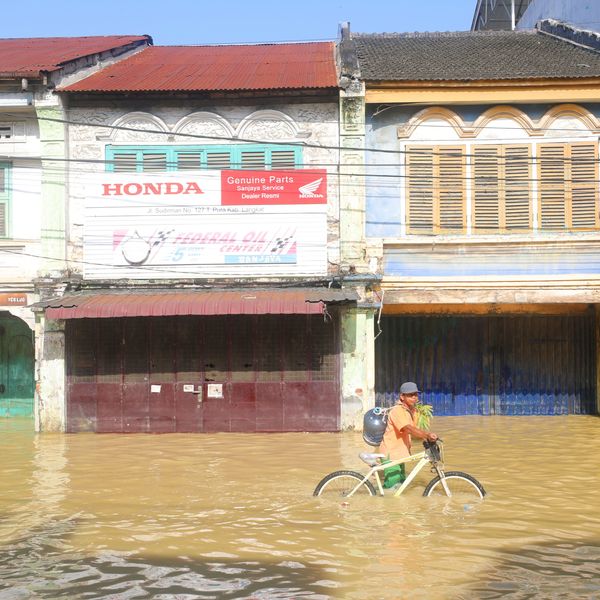'Catastrophe': Oil Spill at Bangladesh World Heritage Site
Fears of long-lasting ecological damage at a UNESCO World Heritage site are mounting following a massive oil spill into a river in Bangladesh.
The disaster began early Tuesday last week when an empty vessel struck a tanker carrying an estimated 92,500 gallons of oil, causing the fuel-filled vessel to capsize in the Shela River. That waterway is part of the biodiverse-rich Sundarbans, the world's largest contiguous mangrove forest and home to the endangered Bengal tiger and Ganges and Irawadi dolphins. An area next to the river is designated as a dolphin sanctuary.
A forest official said Saturday that the spilled furnace oil had spread to an estimated 300 to 350sq kilometers through the mangrove's network of waterways. Hundreds of fishermen in the area are attempting to clean up the oil with pots, pans and sponges, Agence France-Presse reports. The area's chief forest official Amir Hossain told the news agency Thursday that there were "no coordinated efforts to tackle the disaster," and said the air in the area was toxic.
The spill could be "the largest catastrophe to have happened in this fragile mangrove ecosystem," Monirul Khan, a zoology professor of Dhaka's Jahangirnagar University, told AFP. "It's going to cause a long term damage to the forest," he said, adding that the impact could be worse than that of the deadly 2007 cyclone.
Media reports add that environmentalists have long sounded alarm about the risks of using the Shela River to transport such cargo.
Ecology and biodiversity researcher Pavel Partha told the Dhaka Tribune Tuesday that the dolphins "will soon find breathing hard because the thick layer of oil over the river water will reduce the level of dissolved oxygen."
On Sunday, a potential dolphin victim emerged. The Dhaka Tribune published a photo of a dead dolphin floating in a canal off the Shela River, though an autopsy has yet to confirm the death was the result of the oil spill.
Dhaka University botany department Professor Abul Bashar warned of inaction, telling Bangladesh's bdnews24 Monday: "The effect on various species of trees and animals will be visible after at least three generations."
An Urgent Message From Our Co-Founder
Dear Common Dreams reader, The U.S. is on a fast track to authoritarianism like nothing I've ever seen. Meanwhile, corporate news outlets are utterly capitulating to Trump, twisting their coverage to avoid drawing his ire while lining up to stuff cash in his pockets. That's why I believe that Common Dreams is doing the best and most consequential reporting that we've ever done. Our small but mighty team is a progressive reporting powerhouse, covering the news every day that the corporate media never will. Our mission has always been simple: To inform. To inspire. And to ignite change for the common good. Now here's the key piece that I want all our readers to understand: None of this would be possible without your financial support. That's not just some fundraising cliche. It's the absolute and literal truth. We don't accept corporate advertising and never will. We don't have a paywall because we don't think people should be blocked from critical news based on their ability to pay. Everything we do is funded by the donations of readers like you. Will you donate now to help power the nonprofit, independent reporting of Common Dreams? Thank you for being a vital member of our community. Together, we can keep independent journalism alive when it’s needed most. - Craig Brown, Co-founder |
Fears of long-lasting ecological damage at a UNESCO World Heritage site are mounting following a massive oil spill into a river in Bangladesh.
The disaster began early Tuesday last week when an empty vessel struck a tanker carrying an estimated 92,500 gallons of oil, causing the fuel-filled vessel to capsize in the Shela River. That waterway is part of the biodiverse-rich Sundarbans, the world's largest contiguous mangrove forest and home to the endangered Bengal tiger and Ganges and Irawadi dolphins. An area next to the river is designated as a dolphin sanctuary.
A forest official said Saturday that the spilled furnace oil had spread to an estimated 300 to 350sq kilometers through the mangrove's network of waterways. Hundreds of fishermen in the area are attempting to clean up the oil with pots, pans and sponges, Agence France-Presse reports. The area's chief forest official Amir Hossain told the news agency Thursday that there were "no coordinated efforts to tackle the disaster," and said the air in the area was toxic.
The spill could be "the largest catastrophe to have happened in this fragile mangrove ecosystem," Monirul Khan, a zoology professor of Dhaka's Jahangirnagar University, told AFP. "It's going to cause a long term damage to the forest," he said, adding that the impact could be worse than that of the deadly 2007 cyclone.
Media reports add that environmentalists have long sounded alarm about the risks of using the Shela River to transport such cargo.
Ecology and biodiversity researcher Pavel Partha told the Dhaka Tribune Tuesday that the dolphins "will soon find breathing hard because the thick layer of oil over the river water will reduce the level of dissolved oxygen."
On Sunday, a potential dolphin victim emerged. The Dhaka Tribune published a photo of a dead dolphin floating in a canal off the Shela River, though an autopsy has yet to confirm the death was the result of the oil spill.
Dhaka University botany department Professor Abul Bashar warned of inaction, telling Bangladesh's bdnews24 Monday: "The effect on various species of trees and animals will be visible after at least three generations."
Fears of long-lasting ecological damage at a UNESCO World Heritage site are mounting following a massive oil spill into a river in Bangladesh.
The disaster began early Tuesday last week when an empty vessel struck a tanker carrying an estimated 92,500 gallons of oil, causing the fuel-filled vessel to capsize in the Shela River. That waterway is part of the biodiverse-rich Sundarbans, the world's largest contiguous mangrove forest and home to the endangered Bengal tiger and Ganges and Irawadi dolphins. An area next to the river is designated as a dolphin sanctuary.
A forest official said Saturday that the spilled furnace oil had spread to an estimated 300 to 350sq kilometers through the mangrove's network of waterways. Hundreds of fishermen in the area are attempting to clean up the oil with pots, pans and sponges, Agence France-Presse reports. The area's chief forest official Amir Hossain told the news agency Thursday that there were "no coordinated efforts to tackle the disaster," and said the air in the area was toxic.
The spill could be "the largest catastrophe to have happened in this fragile mangrove ecosystem," Monirul Khan, a zoology professor of Dhaka's Jahangirnagar University, told AFP. "It's going to cause a long term damage to the forest," he said, adding that the impact could be worse than that of the deadly 2007 cyclone.
Media reports add that environmentalists have long sounded alarm about the risks of using the Shela River to transport such cargo.
Ecology and biodiversity researcher Pavel Partha told the Dhaka Tribune Tuesday that the dolphins "will soon find breathing hard because the thick layer of oil over the river water will reduce the level of dissolved oxygen."
On Sunday, a potential dolphin victim emerged. The Dhaka Tribune published a photo of a dead dolphin floating in a canal off the Shela River, though an autopsy has yet to confirm the death was the result of the oil spill.
Dhaka University botany department Professor Abul Bashar warned of inaction, telling Bangladesh's bdnews24 Monday: "The effect on various species of trees and animals will be visible after at least three generations."

